B0041VYHGW EBOK (102 page)
Authors: David Bordwell,Kristin Thompson

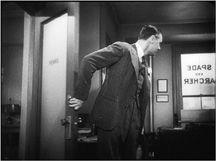
6.70
The Maltese Falcon:
shot 16a.
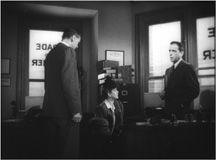
6.71
The Maltese Falcon:
shot 16b.
Now firmly established as part of the scene, Archer hitches himself up onto Spade’s desk. His position puts him at Spade’s end of the axis of action (shot 17,
6.72
). The rest of the scene’s editing analyzes this new set of relationships without ever crossing the 180° line.
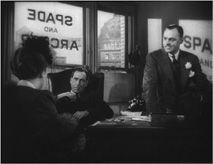
6.72
The Maltese Falcon:
shot 17.
The viewer is not supposed to notice all this. Throughout, the shots present space to emphasize the cause–effect flow—the characters’ actions, entrances, dialogue, reactions. The editing has economically organized space to convey narrative continuity.
The continuity system, in exactly these terms, remains in force today. Most narrative films still draw on 180° principles
(
6.73
,
6.74
).

6.73 In Ron Howard’s
Parenthood,
eyeline-matched shot/reverse shots present a conversation …
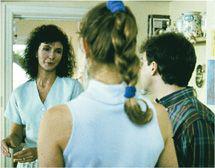
6.74 … with the women in the foreground establishing the axis of action.
CONNECT TO THE BLOG
Shots showing characters’ reactions are often important to the narrative. We talk about how in “They’re looking for us.”
The continuity system can be refined in various ways. If a director arranges several characters in a circular pattern—say, sitting around a dinner table—then the axis of action will probably run between the characters of greatest importance at the moment. In
6.75
and
6.76
, from Howard Hawks’s
Bringing Up Baby,
the important interaction is occurring between the two men, so we can cut from one side of the woman in the foreground to the other side in order to get consistent shot/reverse shots. When one man leaves the table, however, a semicircular arrangement of figures in space is created, so that a new axis of action can be established between the two women. Now we can get shot/reverse-shot exchanges running down the length of the table
(
6.77
,
6.78
).
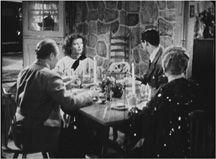
6.75 In
Bringing Up Baby,
the shot/reverse shot between the man on the right …
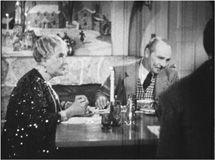
6.76 … and the one on the left gives way to …
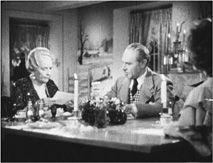
6.77 … a shot/reverse shot between the woman on the left …
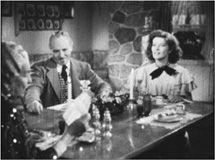
6.78 … and the one on the right.
Both the
Maltese Falcon
and the
Bringing Up Baby
examples show that in the course of a scene the 180° line may shift as the characters move around the setting. In some cases, the filmmaker may create a new axis of action that allows the camera to take up a position that would have crossed the line in an earlier phase of the scene.
“The way [Howard] Hawks constructs a continuity of space is remarkable, and generally holds you ‘inside’ it. There is no possible way of escape, unless the film decides to provide you with one. My theory is that his films are captivating because they build a sense of continuity which is so strong that it allows the complete participation of the audience.”
— Slobodan Sijan, director
The power of the axis of action and the eyelines it can create is so great that the filmmaker may be able to eliminate an establishing shot, thus relying on the Kuleshov effect. In Spike Lee’s
She’s Gotta Have It,
Nola Darling holds a Thanksgiving dinner for her three male friends. Lee never presents a shot showing all four in the same frame. Instead, he uses medium long shots including all the men (for example,
6.79
), over-the-shoulder shot/reverse shots among them (for example,
6.80
), and eyeline-matched medium close-ups of them. Nola is given her own medium close-ups
(
6.81
).
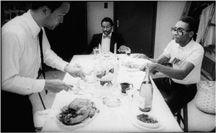
6.79
She’s Gotta Have It.
